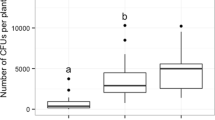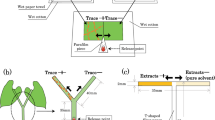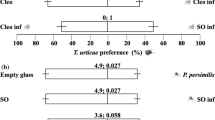Abstract
We determined how conidia of arthropod-pathogenic fungi on leaves affected the behavior of two predators—Orius majusculus (Hemiptera: Anthocoridae) and Phytoseiulus persimilis (Acari: Phytoseiidae)—when offered a choice between preying on two-spotted spider mites, Tetranychus urticae (Acari: Tetranychidae), in the presence or absence of infective conidia of Metarhizium brunneum (Ascomycota: Hypocreales) and Neozygites floridana (Entomophthoromycota: Neozygitaceae). The results indicate no significant relation between the presence of conidia and predator behavior. The only indication of interference is between the generalists O. majusculus and M. brunneum, with a trend towards more time spent feeding and more prey encounters turning into feeding events on leaf discs without conidia than on leaf discs with conidia. Our results show that the presence of fungal conidia does not alter the preying behavior of the predators, and using predators and fungi together is not limited by any interference between organisms in the short term.

Similar content being viewed by others
References
Alma CR, Gillespie DR, Roitberg BD, Goettel MS (2010) Threat of infection and threat-avoidance behavior in the predator Dicyphus hesperus feeding on whitefly nymphs infected with an entomopathogen. J Insect Behav 23:90–99
Asalf B, Stensvand A, Trandem N, Klingen I (2011) Effect of powdery mildew on the interaction between two-spotted spider mite and a predatory mite in strawberry. Acta Hortic 70:101–105
Azevedo AGC, Steinwender BM, Eilenberg J, Sigsgaard L (2017) Interactions among the predatory midge Aphidoletes aphidimyza (Diptera: Cecidomyiidae), the fungal pathogen Metarhizium brunneum (Acomycota: Hypocreales), and maize-infesting aphids in greenhouse mesocosms. Insects 8:44
Bischoff JF, Rehner SA, Humber RA (2009) A multilocus phylogeny of the Metarhizium anisopliae lineage. Mycologia 101:512–530
Boomsma JJ, Jensen AB, Meyling NV, Eilenberg J (2014) Evolutionary interaction networks of insect pathogenic fungi. Annu Rev Entomol 59:467–485
Castro TR, Wekesa VW, Moral RA, Demétrio CGB, Delalibera I, Klingen I (2013) The effects of photoperiod and light intensity on the sporulation of Brazilian and Norwegian isolates of Neozygites floridana. J Invertebr Pathol 114:230–233
Delalibera I, Hajek AE, Humber RA (2003) Use of cell culture media for cultivation of the mite pathogenic fungi Neozygites tanajoae and Neozygites floridana. J Invertebr Pathol 84:119–127
Eilenberg J, Hajek A, Lomer C (2001) Suggestions for unifying the terminology in biological control. Biocontrol 46:387–400
Fathipour Y, Maleknia B (2016) Mite predators. In: Omkar (ed) Ecofriendly pest management for food security. Academic Press, Elsevier, Cambridge, pp 329–366
Fischhoff IR, Keesing F, Ostfeld RS (2017) The tick biocontrol agent Metarhizium brunneum (= M. anisopliae) (strain F52) does not reduce non-target arthropods. PLoS ONE 12:11
Gacheri C, Kigen T, Sigsgaard L (2015) Hot-spot application of biocontrol agents to replace pesticides in large scale commercial rose farms in Kenya. Biocontrol 60:795–803
Gerson U, Weintraub PG (2007) Mites for the control of pests in protected cultivation. Pest Manage Sci 63:658–676
Hajek AE, Eilenberg J (2018) Natural enemies. An introduction to biological control, 2nd edn. Cambridge University Press, Cambridge, p 439
Inglis GD, Enkerli J, Goettel MS (2012) Laboratory techniques used for entomopathogenic fungi: Hypocreales. In: Lacey LA (ed) Manual of techniques in invertebrate pathology. Academic Press, New York, pp 189–253
Keller S (1997) The genus Neozygites (Zygomycetes: Entomophthorales) with special reference to species found in tropical regions. Sydowia 49:118–146
Kennedy GG, Smitley DR (1988) Method of controlling plant feeding mites with the fungus Neozygites floridana. U.S. Patent No 4,752,468, 21 June 1988
Leite LG, Smith L, Moraes GJ, Roberts DW (2000) In vitro production of hyphal bodies of the mite pathogenic fungus Neozygites floridana. Mycologia 92:201–207
McMurtry JA, Croft BA (1997) Life-styles of phytoseiid mites and their roles in biological control. Annu Rev Entomol 42:291–321
Meyling NV, Pell JK (2006) Detection and avoidance of an entomopathogenic fungus by a generalist insect predator. Ecol Entomol 31:162–171
Oduor GI, Moraes GJ, Yaninek JS, van der Geest LPS (1995) Effect of temperature, humidity and photoperiod on mortality of Mononychellus tanajoa (Acari: Tetranychidae) infected by Neozygites cf. floridana (Zygomycetes: Entomophthorales). Exp Appl Acarol 19:571–579
Ormond EL, Thomas APM, Pell JK, Freeman SN, Roy HE (2011) Avoidance of a generalist entomopathogenic fungus by the ladybird, Coccinella septempunctata. FEMS Microbiol Ecol 77:229–237
Pourian H-R, Talaei-Hassanloui R, Kosari AA, Ashouri A (2011) Effects of Metarhizium anisopliae on searching, feeding and predation by Orius albidipennis (Hem., Anthocoridae) on Thrips tabaci (Thy., Thripidae) larvae. Biocontrol Sci Technol 21:15–21
R Core Team (2015) R: a language and environment for statistical computing. R Foundation for Statistical Computing, Vienna, Austria. https://www.R-project.org/. Accessed 2 Oct 2019
Rauch H, Steinwender BM, Mayhofer J, Sigsgaard L, Eilenberg J, Enkerli J, Zelger R, Strasser H (2017) Field efficacy of Heterorhabditis bacteriophora (Nematoda: Heterorhabditidae), Metarhizium brunneum (Hypocrales: Clavicipitaceae), and chemical insecticide combinations for Diabrotica virgifera larval management. Biol Control 107:1–7
Roy HE, Pell JK (2000) Interactions between entomopathogenic fungi and other natural enemies: implications for biological control. Biocontrol Sci Technol 10:737–752
Roy HE, Pell JK, Clark SJ, Alderson PG (1998) Implications of predator foraging on aphid pathogen dynamics. J Invertebr Pathol 71:236–247
Seiedy M, Saboori A, Allahyari H (2012) Interactions of two natural enemies of Tetranychus urticae, the fungal entomopathogen Beauveria bassiana and the predatory mite, Phytoseiulus persimilis. Biocontrol Sci Technol 22:873–882
Trandem T, Bhattarai UR, Westrum K, Knudsen GK, Klingen I (2015) Fatal attraction: male spider mites prefer females killed by the mite-pathogenic fungus Neozygites floridana. J Invertebr Pathol 128:6–13
Trandem N, Berdinesen R, Pell JK, Klingen I (2016) Interactions between natural enemies: effect of a predatory mite on transmission of the fungus Neozygites floridana in two-spotted spider mite populations. J Invertebr Pathol 134:35–37
van Lenteren JC (2012) The state of commercial augmentative biological control: plenty of natural enemies, but a frustrating lack of uptake. Biocontrol 57:1–20
Wekesa VW, Moraes GJ, Knapp M, Delalibera I Jr (2007) Interactions of two natural enemies of Tetranychus evansi, the fungal pathogen Neozygites floridana (Zygomycetes: Entomophthorales) and the predatory mite, Phytoseiulus longipes (Acari: Phytoseiidae). Biol Control 41:408–414
Wekesa VW, Moraes GJ, Ortega EMM, Delaibera I Jr (2010) Effect of temperature on sporulation of Neozygites floridana isolates from different climates and their virulence against the tomato red spider mite, Tetranychus evansi. J Invertebr Pathol 103:36–42
Wu S, Gao Y, Smagghe G, Xu X, Lei Z (2016) Interactions between the entomopathogenic fungus Beauveria bassiana and the predatory mite Neoseiulus barkeri and biological control of their shared prey/host Frankliniella occidentalis. Biol Control 98:43–51
Acknowledgements
We thank Karin Westrum (NIBIO) and Natasha Iwanicki (University of São Paulo, ESALQ) for assistance throughout the experiment. Professor Italo Delalibera Jr. and his group at ESALQ-USP are acknowledged for providing the N. floridana isolate ESALQ 1420 used in this study. We also thank the anonymous reviewers and associate editor of the journal for devoting their time into improving the manuscript. This study is part of the research project IMBICONT (Improved Biological Control for IPM in Fruits and Berries) (Project Number 1024151001) funded by the Innovation Fund, Denmark, and also supported by the project BERRYSYS (project number 190407/110) funded by the Norwegian Foundation for Research Levy on Agricultural Products (FFL) and the Agricultural Agreement Research Funds (JA) and the project SMARTCROP (Project Number 244626) funded by The Research Council of Norway.
Author information
Authors and Affiliations
Corresponding author
Additional information
Publisher's Note
Springer Nature remains neutral with regard to jurisdictional claims in published maps and institutional affiliations.
Rights and permissions
About this article
Cite this article
Jacobsen, S.K., Klingen, I., Eilenberg, J. et al. Entomopathogenic fungal conidia marginally affect the behavior of the predators Orius majusculus (Hemiptera: Anthocoridae) and Phytoseiulus persimilis (Acari: Phytoseiidae) foraging for healthy Tetranychus urticae (Acari: Tetranychidae). Exp Appl Acarol 79, 299–307 (2019). https://doi.org/10.1007/s10493-019-00441-w
Received:
Accepted:
Published:
Issue Date:
DOI: https://doi.org/10.1007/s10493-019-00441-w




